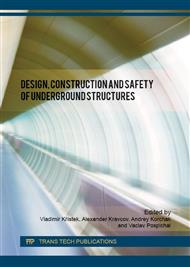[1]
Akhverdov I. N. Basic physics of concrete. – M.: Stroiizdat, 1981, s.
Google Scholar
[2]
Kulikov Yu. N. Design the mobility of the concrete mixtures to the underground construction. – M.: Moscow state mining University. Mining Informational Analytic Bulletin, No. 2, Moscow, (1997).
Google Scholar
[3]
Kulikova E. Yu., Assessment of the operating environment of the concrete lining of a sewage collector tunnels. – M.: PROC No. 8, MSMU, 2007, pp.21-28.
Google Scholar
[4]
Yao Y., Ling W., Wittmann F.H. Publications on Durability of Reinforced Concrete Structures under Combined Mechanical Loads and Environmental Actions: An Annotated Bibliography. – Aedificatio Pulishers, Feriburg, Germany (2013).
Google Scholar
[5]
Colin R. Cement and concrete as an engineering material: An historic appraisal and case study analysis. – Engineering Failure Analysis. – Volume 40, May 2014, p.114–140.
DOI: 10.1016/j.engfailanal.2014.02.004
Google Scholar
[6]
Franzen T., Bergdahl S. -G., Nordmark A. Underground construction in modern infrastructure. – Proceedings of the International Conference on Underground Construction in Modern Infrastructure, Stockholm, Sweden, 7-9 June (1998).
Google Scholar
[7]
Concrete for Underground Structures: Guidelines for Design and Construction. Eluted by Robert J. F. Goodfellow. – Society for Mining, Metallurgy and Exploration. – 2011. – 78p.
Google Scholar
[8]
Pintado X., Barragán B.E. Homogeneity of self-compacting concretes used in tunnel strengthening – A case study. – Tunneling and Underground Space Technology. – Volume 24, Issue 6, November 2009, p.647–653.
DOI: 10.1016/j.tust.2009.06.005
Google Scholar
[9]
Tang S.W., Yao Y., Andrade C. Recent durability studies on concrete structure. – Volume 78, Part A, December 2015, p.143–154. – Keynote papers from 14th International Congress on the Chemistry of Cement (ICCC 2015).
DOI: 10.1016/j.cemconres.2015.05.021
Google Scholar
[10]
Desmettre C., Charron J.P. Water permeability of reinforced concrete subjected to cyclic tensile loading ACI Mater. J., 110 (2013), p.67–78.
DOI: 10.14359/51684368
Google Scholar
[11]
Stukovnik P., Princic T., Pejovnik R.S., Bosiljkov V.B. Alkali–carbonate reaction in concrete and its implications for a high rate of long-term compressive strength increase. – Constr. Build. Mater., 50 (2014), p.699–709.
DOI: 10.1016/j.conbuildmat.2013.10.007
Google Scholar
[12]
Lambert P., Brueckner R., Atkins C. Degradation of Cement and Concrete – Reference Module in Materials Science and Materials Engineering. – Shreir's Corrosion, 2010, p.2348–2368.
DOI: 10.1016/b978-044452787-5.00115-3
Google Scholar
[13]
Flatt R. Superplasticizers and the rheology of concrete. – Understanding the Rheology of Concrete. – A volume in Woodhead Publishing Series in Civil and Structural Engineering. – 2012, p.144–208.
DOI: 10.1533/9780857095282.2.144
Google Scholar
[14]
Li Z.J. Advanced Concrete Technology. – John Wiley & Sons, Hoboken (2011).
Google Scholar
[15]
Yuan Y., Jiang X., Lee C.F. Tunnel waterproofing practices in China. – Tunneling and Underground Space Technology. - Volume 15, Issue 2, April–June 2000, p.227–233.
DOI: 10.1016/s0886-7798(00)00048-1
Google Scholar
[16]
Mehta P.K., Monteiro P.J.M. Concrete: Microstructure, Properties and Materials. – (3rd ed. ). – McGraw-Hill, New York (2006).
Google Scholar
[17]
Bellégo C.L., Cabot G.P., Gérard B., Dubé J.F., Molez L. Coupled mechanical and chemical damage in calcium leached cementitious structures. – J. Eng. Mech. ASCE, 129 (2003), p.333–341.
DOI: 10.1061/(asce)0733-9399(2003)129:3(333)
Google Scholar
[18]
Desmettre C., Charron J.P. Water permeability of reinforced concrete subjected to cyclic tensile loading. – ACI Mater. J., 110 (2013), p.67–78.
DOI: 10.14359/51684368
Google Scholar
[19]
Khelidj A., Choinska M. Coupling between mechanical damage, temperature, and permeability of concrete: experimental and some numerical studies. – Proceeding of the 1st International Conference on Performance-Based and Life-Cycle Structural Engineering, Hong Kong, China (December, 5–7 2012), p.906.
Google Scholar
[20]
Banthia N., Biparva A., Mindess S. Permeability of concrete under stress. – Cem. Concr. Res., 35 (2005), p.1651–1655.
DOI: 10.1016/j.cemconres.2004.10.044
Google Scholar


